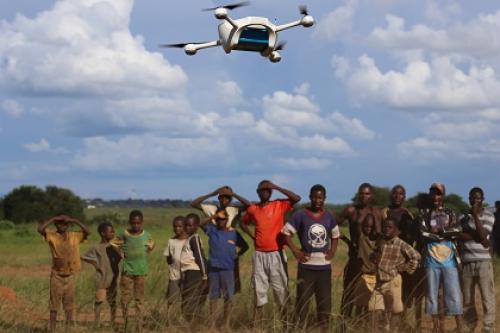The Government of Malawi and UNICEF announce first humanitarian drone testing corridor in Africa
The Government of Malawi and UNICEF have announced the establishment of an air corridor to test potential humanitarian use of unmanned aircraft systems (UAS) - also known as drones.

Children in Malawi watch a community drone demonstration in Lilongwe. In March, the Ministry of Health and UNICEF launched the first 10km auto programmed flight to speed up testing and diagnosis of HIV in infants.
The corridor is the first in Africa and one of the first globally with a focus on humanitarian and development use. It will run for a maximum distance of 40 km and become fully operational by April 2017. The corridor is designed to provide a controlled platform for the private sector, universities, and other partners to explore how UAS can be used to help deliver services that will benefit communities.
“Malawi has over the past years faced serious droughts and flooding,” Malawi’s Minister of Transport and Public Works, Jappie Mhango said. “The launch of the UAS testing corridor is particularly important to support transportation and data collection where land transport infrastructure is either not feasible or difficult during emergencies.”
The Humanitarian UAS Testing Corridor will facilitate testing in three main areas:
• Imagery – generating and analyzing aerial images for development and during humanitarian crises, including for situation monitoring in floods and earthquakes
• Connectivity – exploring the possibility for UAS to extend Wi-Fi or cellphone signals across difficult terrain, particularly in emergency settings
• Transport – delivery of small low weight supplies such as emergency medical supplies, vaccines and samples for laboratory diagnosis, including for HIV testing.
UAS technology is still in the early stages of development. UNICEF is working globally with a number of governments and private sector partners to explore how UAS can be used in low income countries. All projects adhere to a strict set of innovation principles, with a focus on open source and user-centered design.
“The establishment of the testing corridor means there is now a place where we can explore the potential of UAS in the development and humanitarian space,” said Cynthia McCaffrey, Director of UNICEF’s Office of Innovation. “This programme allows UNICEF to adapt to rapid developments in UAS technology and potentially integrate UAS into our work for children.”
The launch of the UAS testing corridor follows a pilot project in March 2016 on the feasibility of using UAS for the transportation of dried blood samples for early infant diagnosis of HIV. The feasibility study conducted earlier this year showed that UAS are a viable addition to existing transport systems including those used to help with the diagnosis of HIV.
UNICEF will be finalizing agreements with applicant companies and institutions in the coming months. The Government of Malawi and UNICEF will also identify potential UAS operators that can function in the case of disasters in the region and put in place stand-by agreements to ensure a rapid emergency response.
Source:United Nations Children's Fund
- 323 reads
Human Rights
Ringing FOWPAL’s Peace Bell for the World:Nobel Peace Prize Laureates’ Visions and Actions

Protecting the World’s Cultural Diversity for a Sustainable Future

The Peace Bell Resonates at the 27th Eurasian Economic Summit

Declaration of World Day of the Power of Hope Endorsed by People in 158 Nations

Puppet Show I International Friendship Day 2020

